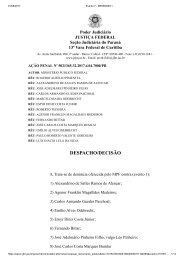War in Ukraine Lives and livelihoods, lost and disrupted Report
he Russian invasion of Ukraine has caused the greatest humanitarian crisis in Europe since the Second World War. Already, thousands of lives have been lost, and millions of livelihoods have been disrupted through displacement, lost homes, and lost incomes (Exhibit 1). We, like so many others, are shocked by the unfolding humanitarian tragedy and the consequences of this brutal war.
he Russian invasion of Ukraine has caused the greatest humanitarian crisis in Europe since the Second World War. Already, thousands of lives have been lost, and millions of livelihoods have been disrupted through displacement, lost homes, and lost incomes (Exhibit 1). We, like so many others, are shocked by the unfolding humanitarian tragedy and the consequences of this brutal war.
- No tags were found...
Create successful ePaper yourself
Turn your PDF publications into a flip-book with our unique Google optimized e-Paper software.
Energy is a particular concern (and is a key
parameter across scenarios 2 ). European natural-gas
prices have jumped 60 percent since Russia started
massing troops. Brent crude oil is consistently
trading near $120 per barrel. Further, prices for key
agricultural, mineral, and metal commodities rose
10 to 15 percent in the first week of the conflict;
nickel prices doubled recently. Ukraine and Russia
together produce about 30 percent of global wheat;
spot market prices are up about 40 percent. They
are also the largest producers of class 1 nickel (used
in electric-vehicle batteries), with a 23 percent
global share, and the second-largest producers of
palladium (used in catalytic converters), holding a
38 percent global share.
The spike in commodity prices has shaken the
confidence of consumers and businesses globally.
Regardless of which scenario ultimately plays out,
households may remain cautious and will keep on
the sidelines the excess savings that they have
accumulated during the pandemic, at least in the near
term, even as the economy fully reopens. Businesses
may look to slow all but necessary expenditures
and hiring. And the US Federal Reserve and the
European Central Bank have, as of March 11, 2022,
stated that they see the risks of accelerating inflation
to be greater than those of potentially weak demand
and are moving to halt the inflation cycle by initiating
a steady pace of interest-rate increases.
Initial economic scenarios for
the eurozone
We have modeled three scenarios—1B, 2A, and
3B—which may help leaders and decision makers
bound uncertainty as it appears today. Scenario 1B
captures contained disruption with moderate policy
response. Scenario 2A looks at extended disruption
and robust policy response. Finally, scenario 3B
considers outcomes from a severe, escalating
disruption, but still with moderate policy response.
(Scenario 3C is also a distinct possibility, if central
banks act more aggressively to fight inflation and
the conflict endures for some time.)
In what follows, we focus on the eurozone, which
is the world’s largest macroeconomy and highly
exposed to the conflict. At the conclusion of this
section, we offer some considerations for other
geographies. Here, we do not analyze Eastern
Europe per se but are keenly aware that these
nations will see direct and significant impact from
the economic disruption, as well as the burgeoning
refugee crisis. We use GDP to measure impact
on livelihoods, as incomes are a substantial
component of GDP. As is standard in scenario
analyses, any point estimates in our calculations are
not forecasts but merely the center point of a range
of potential outcomes.
Scenario 1B: Contained disruption with moderate
policy response
In this scenario, the end of hostilities occurs within a
few more weeks. Sanctions do not escalate further
and may even be scaled back; energy exports from
Russia to Europe keep flowing. Before the end of
2022, natural-gas prices in Europe return to their
precrisis peak of about $30 per million British
thermal units (MMBtu); Brent crude returns to
$70 to $80 per barrel. GDP growth (and thus jobs
and incomes) across the eurozone reverts to its
precrisis trend, albeit with a first-quarter slowdown,
reflecting the shock of the invasion.
Inflation expectations remain elevated relative
to prepandemic norms but are stable, and the
European Central Bank continues to reduce
monetary stimulus. Consumer confidence reverts to
its prepandemic level, and businesses continue their
COVID-19-exit investment plans through most of the
eurozone by the second quarter of 2022.
Eurozone GDP growth in 2022 returns to a
preinvasion trajectory of 3.8 percent. Growth falls
to 2.7 percent in 2023 and 1.5 percent in 2024
as economies return to their long-term trends.
Germany, the largest economy in the eurozone,
follows a similar trajectory: growth of 3.5 percent in
2022, 3.0 percent in 2023, and 1.3 percent in 2024.
Exhibit 3 sets out estimated GDP growth for each of
the three scenarios.
2
Energy supply, demand, and price assumptions were developed in partnership with McKinsey Energy Insights.
War in Ukraine: Lives and livelihoods, lost and disrupted
7








